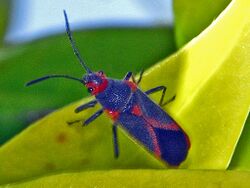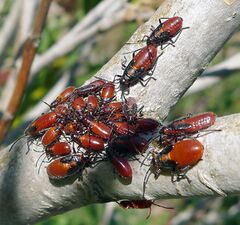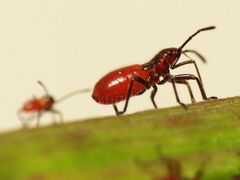Biology:Caenocoris nerii
| Caenocoris nerii | |
|---|---|

| |
| Caenocoris nerii, upperside | |

| |
| Side view | |
| Scientific classification | |
| Domain: | Eukaryota |
| Kingdom: | Animalia |
| Phylum: | Arthropoda |
| Class: | Insecta |
| Order: | Hemiptera |
| Suborder: | Heteroptera |
| Family: | Lygaeidae |
| Genus: | Caenocoris |
| Species: | C. nerii
|
| Binomial name | |
| Caenocoris nerii (Germar, 1847)
| |
Caenocoris nerii, common name oleander seedbug, is a species of ground bugs in the insect family Lygaeidae.[1]
Etymology
The species name nerii refers to the main host plant Nerium oleander.
Distribution
This species is present in part of Europe (Albania, Bulgaria, Cyprus, France , Greece, Italy and Spain ), in the Afrotropical realm and in the Indomalayan realm.[2][3][4]
Description
Caenocoris nerii can reach a length of about 7.5–9.5 millimetres (0.30–0.37 in).[5] The female is larger than the male. Bodies are elongated. The basic color of the body is black, with red markings. Two red quadrangular patches are present on the head. Two red markings appear on the shoulders of pronotum and at the inner margins of the hemielytra, which only partially cover the membranous blackish wings. Scutellum and abdomen are completely red.[6][7]
Biology
Females usually lay eggs on the leaves of Nerium oleander (hence the common name of the species). All stages of nymphs suck almost exclusively the milky juice of the main host plant (Nerium oleander), but they may also feed on Asclepiadaceae species.[6] Nynphs overwinter. Adults normally feed on the Oleander's fruits and seed.[8] These aposematic bugs are usually rejected by predators because of their toxins derived from the host plant.[9][10]
References
- ↑ Biolib
- ↑ Fauna europaea[|permanent dead link|dead link}}]
- ↑ Inaturalist
- ↑ Lygaeoidea
- ↑ Jean-Claude Stretto, Gérard Labonne, Gérard Duvallet, François Dusoulier Caenocoris nerii (Germar, 1847) à la conquête de la France méditerranéenne (Hemiptera Heteroptera Lygaeidae)
- ↑ 6.0 6.1 Carl W. Schaefer,Antonio Ricardo Heteroptera of Economic Importance
- ↑ Animalandia (in Spanish)
- ↑ DL Evans Cardenolides in the Defense of Caenocoris nerii (Hemiptera)
- ↑ S. Bettini Arthropod Venoms
- ↑ Euw, J. von. Reichstein, T. Rothschild, M. Heart poisons (cardiac glycosides) in the lygaeid bugs Caenocoris nerii and Spilostethus pandurus (1971) United States Department of Agriculture - National Agricultural Library
- Slater, J.A. 1964. A Catalogue of the Lygaeidae of the World. 42-43
External links
Wikidata ☰ Q30326319 entry
 |



